Leadership Style, Culture and Management Practice: A Case Study of Tesco PLC
VerifiedAdded on 2024/06/28
|14
|2798
|162
AI Summary
This research paper explores the interplay of leadership style, organizational culture, and management practices within Tesco PLC, a leading multinational grocery retailer. Through a case study analysis, the paper examines how these elements contribute to the company's success and identifies areas for improvement. The research delves into the history of Tesco PLC, its business summary, and the rationale for choosing it as a case study. It then analyzes the company's vision, leadership style, management practices, and organizational culture, highlighting the influence of these factors on business functions. Finally, the paper provides recommendations for enhancing Tesco PLC's leadership, management, and cultural practices to further optimize its performance.
Contribute Materials
Your contribution can guide someone’s learning journey. Share your
documents today.
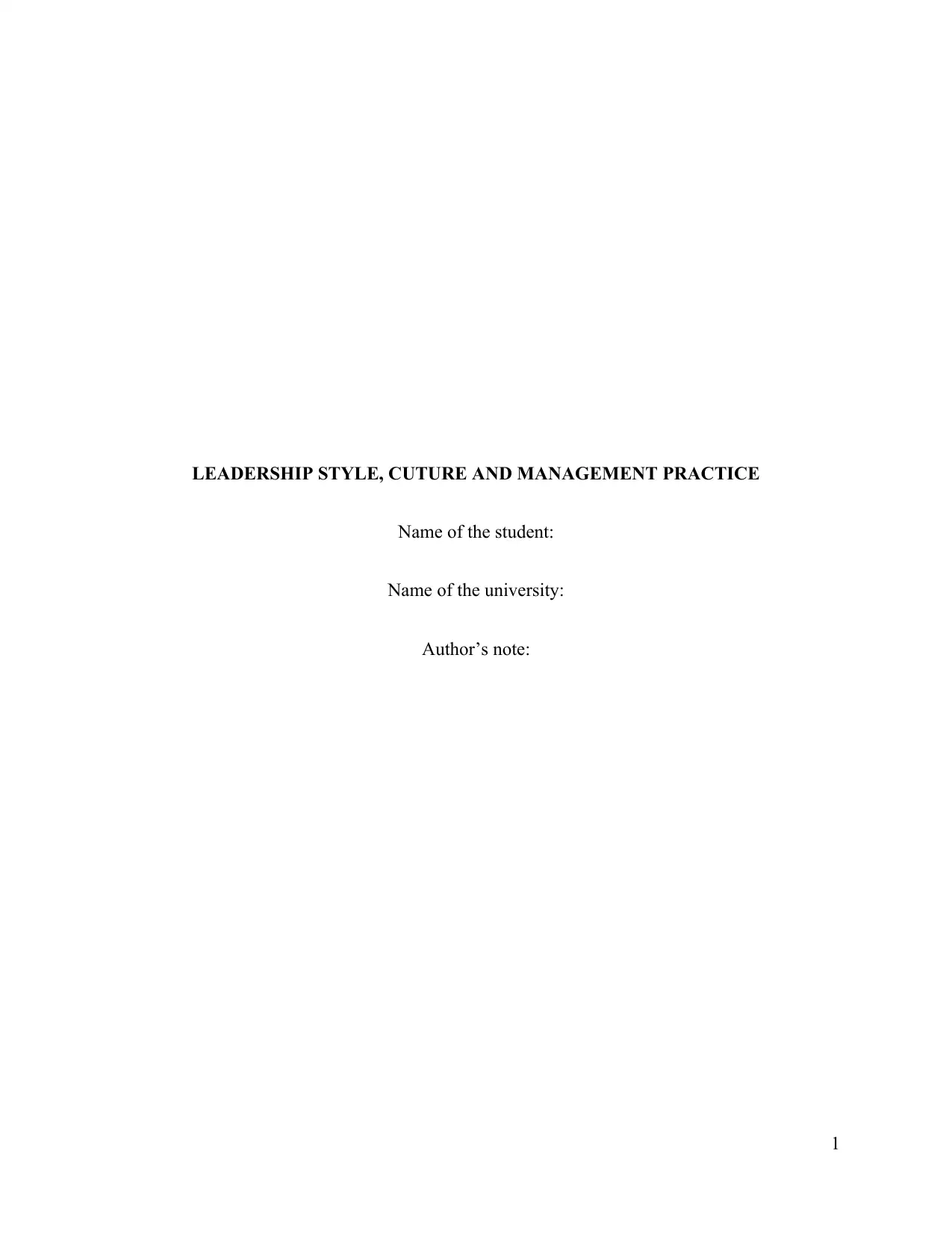
LEADERSHIP STYLE, CUTURE AND MANAGEMENT PRACTICE
Name of the student:
Name of the university:
Author’s note:
1
Name of the student:
Name of the university:
Author’s note:
1
Secure Best Marks with AI Grader
Need help grading? Try our AI Grader for instant feedback on your assignments.
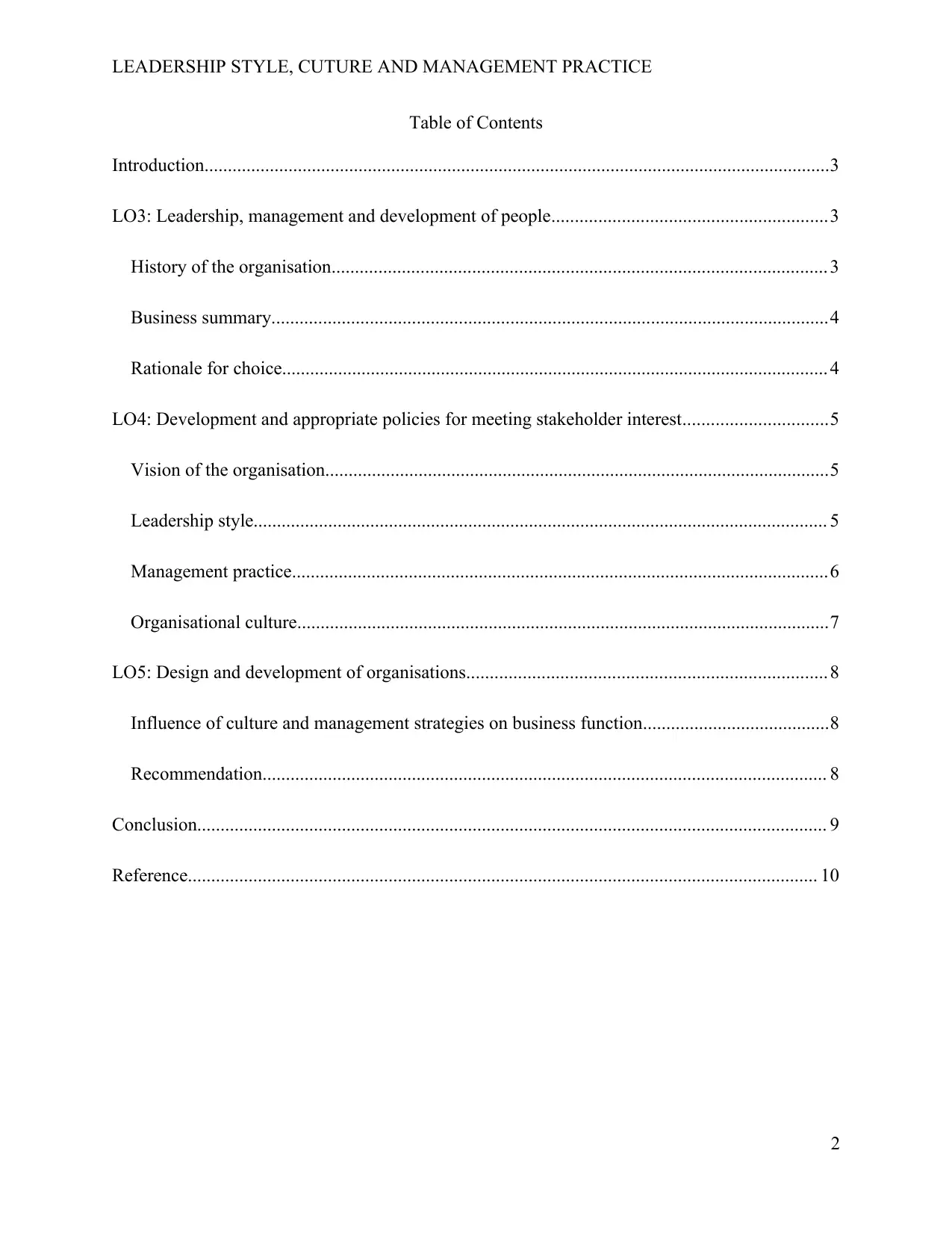
LEADERSHIP STYLE, CUTURE AND MANAGEMENT PRACTICE
Table of Contents
Introduction......................................................................................................................................3
LO3: Leadership, management and development of people...........................................................3
History of the organisation.......................................................................................................... 3
Business summary.......................................................................................................................4
Rationale for choice..................................................................................................................... 4
LO4: Development and appropriate policies for meeting stakeholder interest...............................5
Vision of the organisation............................................................................................................5
Leadership style........................................................................................................................... 5
Management practice...................................................................................................................6
Organisational culture..................................................................................................................7
LO5: Design and development of organisations.............................................................................8
Influence of culture and management strategies on business function........................................8
Recommendation......................................................................................................................... 8
Conclusion....................................................................................................................................... 9
Reference....................................................................................................................................... 10
2
Table of Contents
Introduction......................................................................................................................................3
LO3: Leadership, management and development of people...........................................................3
History of the organisation.......................................................................................................... 3
Business summary.......................................................................................................................4
Rationale for choice..................................................................................................................... 4
LO4: Development and appropriate policies for meeting stakeholder interest...............................5
Vision of the organisation............................................................................................................5
Leadership style........................................................................................................................... 5
Management practice...................................................................................................................6
Organisational culture..................................................................................................................7
LO5: Design and development of organisations.............................................................................8
Influence of culture and management strategies on business function........................................8
Recommendation......................................................................................................................... 8
Conclusion....................................................................................................................................... 9
Reference....................................................................................................................................... 10
2
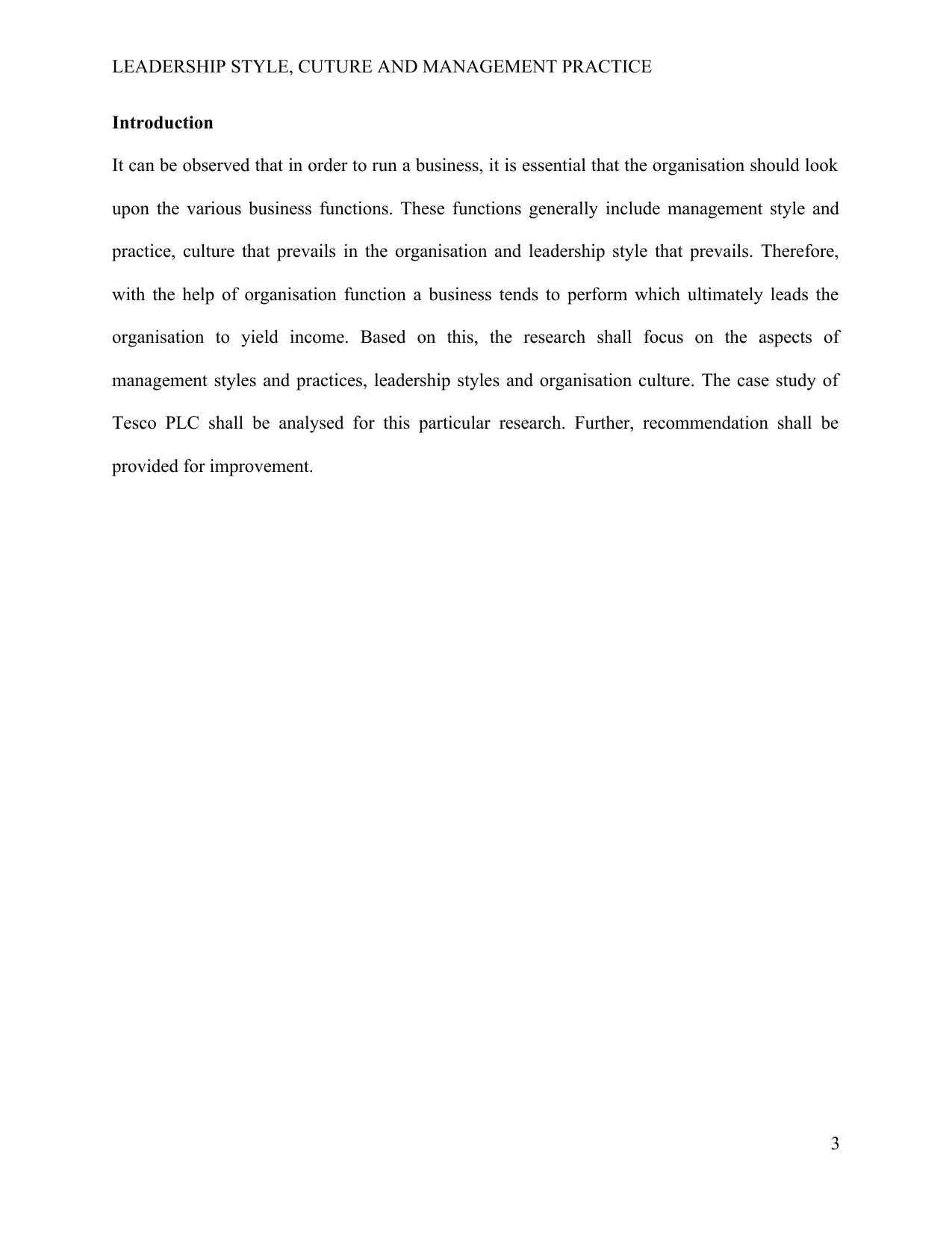
LEADERSHIP STYLE, CUTURE AND MANAGEMENT PRACTICE
Introduction
It can be observed that in order to run a business, it is essential that the organisation should look
upon the various business functions. These functions generally include management style and
practice, culture that prevails in the organisation and leadership style that prevails. Therefore,
with the help of organisation function a business tends to perform which ultimately leads the
organisation to yield income. Based on this, the research shall focus on the aspects of
management styles and practices, leadership styles and organisation culture. The case study of
Tesco PLC shall be analysed for this particular research. Further, recommendation shall be
provided for improvement.
3
Introduction
It can be observed that in order to run a business, it is essential that the organisation should look
upon the various business functions. These functions generally include management style and
practice, culture that prevails in the organisation and leadership style that prevails. Therefore,
with the help of organisation function a business tends to perform which ultimately leads the
organisation to yield income. Based on this, the research shall focus on the aspects of
management styles and practices, leadership styles and organisation culture. The case study of
Tesco PLC shall be analysed for this particular research. Further, recommendation shall be
provided for improvement.
3
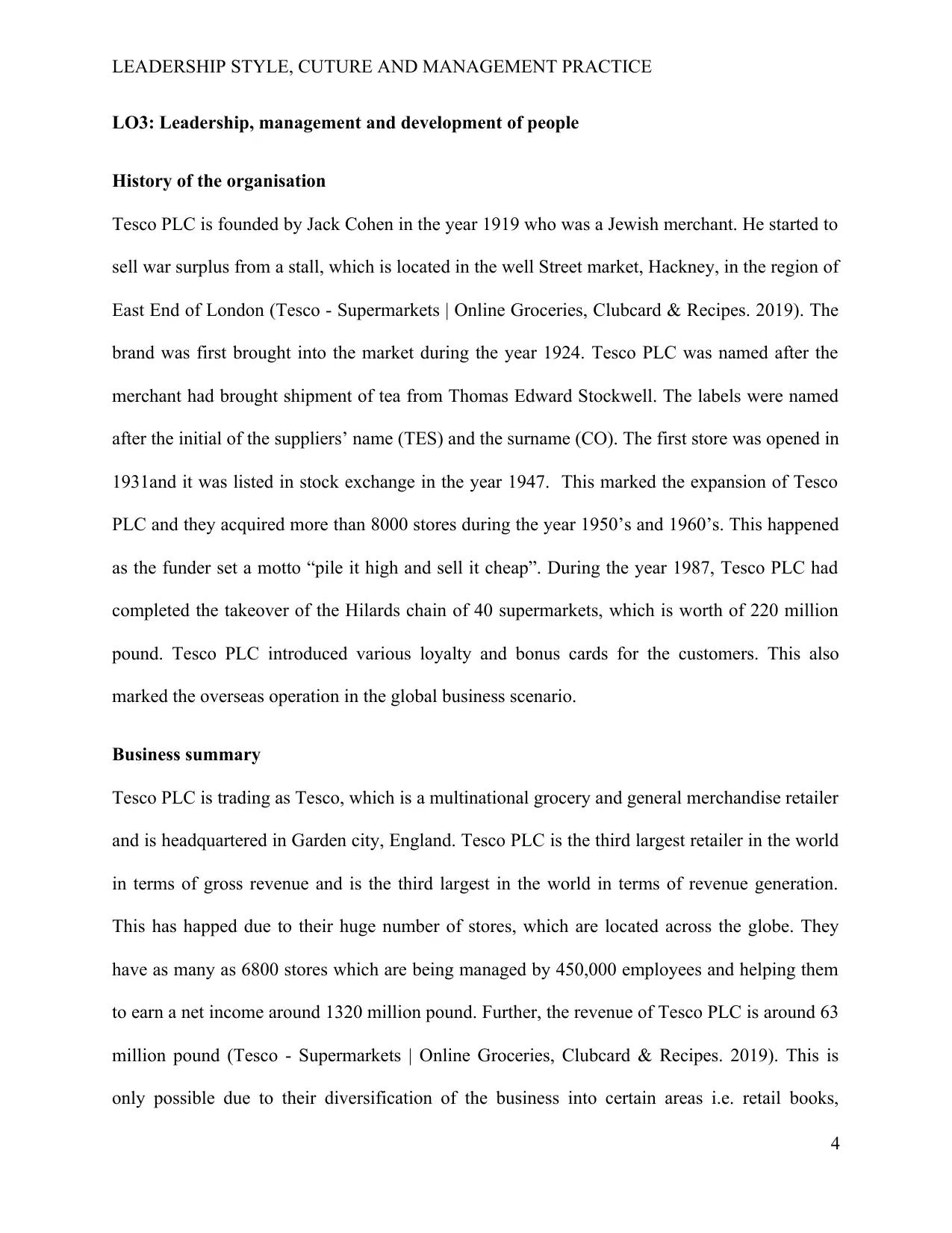
LEADERSHIP STYLE, CUTURE AND MANAGEMENT PRACTICE
LO3: Leadership, management and development of people
History of the organisation
Tesco PLC is founded by Jack Cohen in the year 1919 who was a Jewish merchant. He started to
sell war surplus from a stall, which is located in the well Street market, Hackney, in the region of
East End of London (Tesco - Supermarkets | Online Groceries, Clubcard & Recipes. 2019). The
brand was first brought into the market during the year 1924. Tesco PLC was named after the
merchant had brought shipment of tea from Thomas Edward Stockwell. The labels were named
after the initial of the suppliers’ name (TES) and the surname (CO). The first store was opened in
1931and it was listed in stock exchange in the year 1947. This marked the expansion of Tesco
PLC and they acquired more than 8000 stores during the year 1950’s and 1960’s. This happened
as the funder set a motto “pile it high and sell it cheap”. During the year 1987, Tesco PLC had
completed the takeover of the Hilards chain of 40 supermarkets, which is worth of 220 million
pound. Tesco PLC introduced various loyalty and bonus cards for the customers. This also
marked the overseas operation in the global business scenario.
Business summary
Tesco PLC is trading as Tesco, which is a multinational grocery and general merchandise retailer
and is headquartered in Garden city, England. Tesco PLC is the third largest retailer in the world
in terms of gross revenue and is the third largest in the world in terms of revenue generation.
This has happed due to their huge number of stores, which are located across the globe. They
have as many as 6800 stores which are being managed by 450,000 employees and helping them
to earn a net income around 1320 million pound. Further, the revenue of Tesco PLC is around 63
million pound (Tesco - Supermarkets | Online Groceries, Clubcard & Recipes. 2019). This is
only possible due to their diversification of the business into certain areas i.e. retail books,
4
LO3: Leadership, management and development of people
History of the organisation
Tesco PLC is founded by Jack Cohen in the year 1919 who was a Jewish merchant. He started to
sell war surplus from a stall, which is located in the well Street market, Hackney, in the region of
East End of London (Tesco - Supermarkets | Online Groceries, Clubcard & Recipes. 2019). The
brand was first brought into the market during the year 1924. Tesco PLC was named after the
merchant had brought shipment of tea from Thomas Edward Stockwell. The labels were named
after the initial of the suppliers’ name (TES) and the surname (CO). The first store was opened in
1931and it was listed in stock exchange in the year 1947. This marked the expansion of Tesco
PLC and they acquired more than 8000 stores during the year 1950’s and 1960’s. This happened
as the funder set a motto “pile it high and sell it cheap”. During the year 1987, Tesco PLC had
completed the takeover of the Hilards chain of 40 supermarkets, which is worth of 220 million
pound. Tesco PLC introduced various loyalty and bonus cards for the customers. This also
marked the overseas operation in the global business scenario.
Business summary
Tesco PLC is trading as Tesco, which is a multinational grocery and general merchandise retailer
and is headquartered in Garden city, England. Tesco PLC is the third largest retailer in the world
in terms of gross revenue and is the third largest in the world in terms of revenue generation.
This has happed due to their huge number of stores, which are located across the globe. They
have as many as 6800 stores which are being managed by 450,000 employees and helping them
to earn a net income around 1320 million pound. Further, the revenue of Tesco PLC is around 63
million pound (Tesco - Supermarkets | Online Groceries, Clubcard & Recipes. 2019). This is
only possible due to their diversification of the business into certain areas i.e. retail books,
4
Secure Best Marks with AI Grader
Need help grading? Try our AI Grader for instant feedback on your assignments.
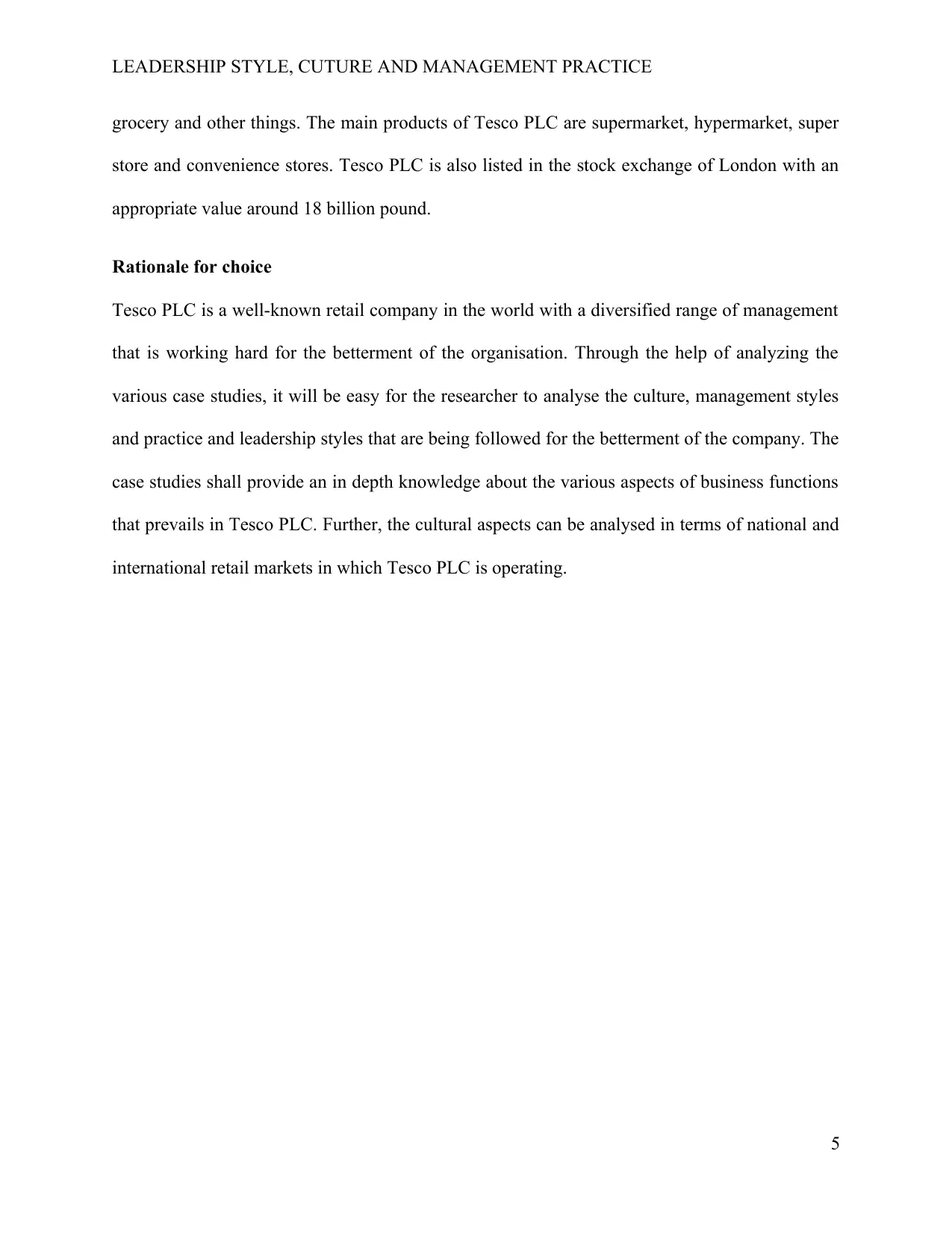
LEADERSHIP STYLE, CUTURE AND MANAGEMENT PRACTICE
grocery and other things. The main products of Tesco PLC are supermarket, hypermarket, super
store and convenience stores. Tesco PLC is also listed in the stock exchange of London with an
appropriate value around 18 billion pound.
Rationale for choice
Tesco PLC is a well-known retail company in the world with a diversified range of management
that is working hard for the betterment of the organisation. Through the help of analyzing the
various case studies, it will be easy for the researcher to analyse the culture, management styles
and practice and leadership styles that are being followed for the betterment of the company. The
case studies shall provide an in depth knowledge about the various aspects of business functions
that prevails in Tesco PLC. Further, the cultural aspects can be analysed in terms of national and
international retail markets in which Tesco PLC is operating.
5
grocery and other things. The main products of Tesco PLC are supermarket, hypermarket, super
store and convenience stores. Tesco PLC is also listed in the stock exchange of London with an
appropriate value around 18 billion pound.
Rationale for choice
Tesco PLC is a well-known retail company in the world with a diversified range of management
that is working hard for the betterment of the organisation. Through the help of analyzing the
various case studies, it will be easy for the researcher to analyse the culture, management styles
and practice and leadership styles that are being followed for the betterment of the company. The
case studies shall provide an in depth knowledge about the various aspects of business functions
that prevails in Tesco PLC. Further, the cultural aspects can be analysed in terms of national and
international retail markets in which Tesco PLC is operating.
5
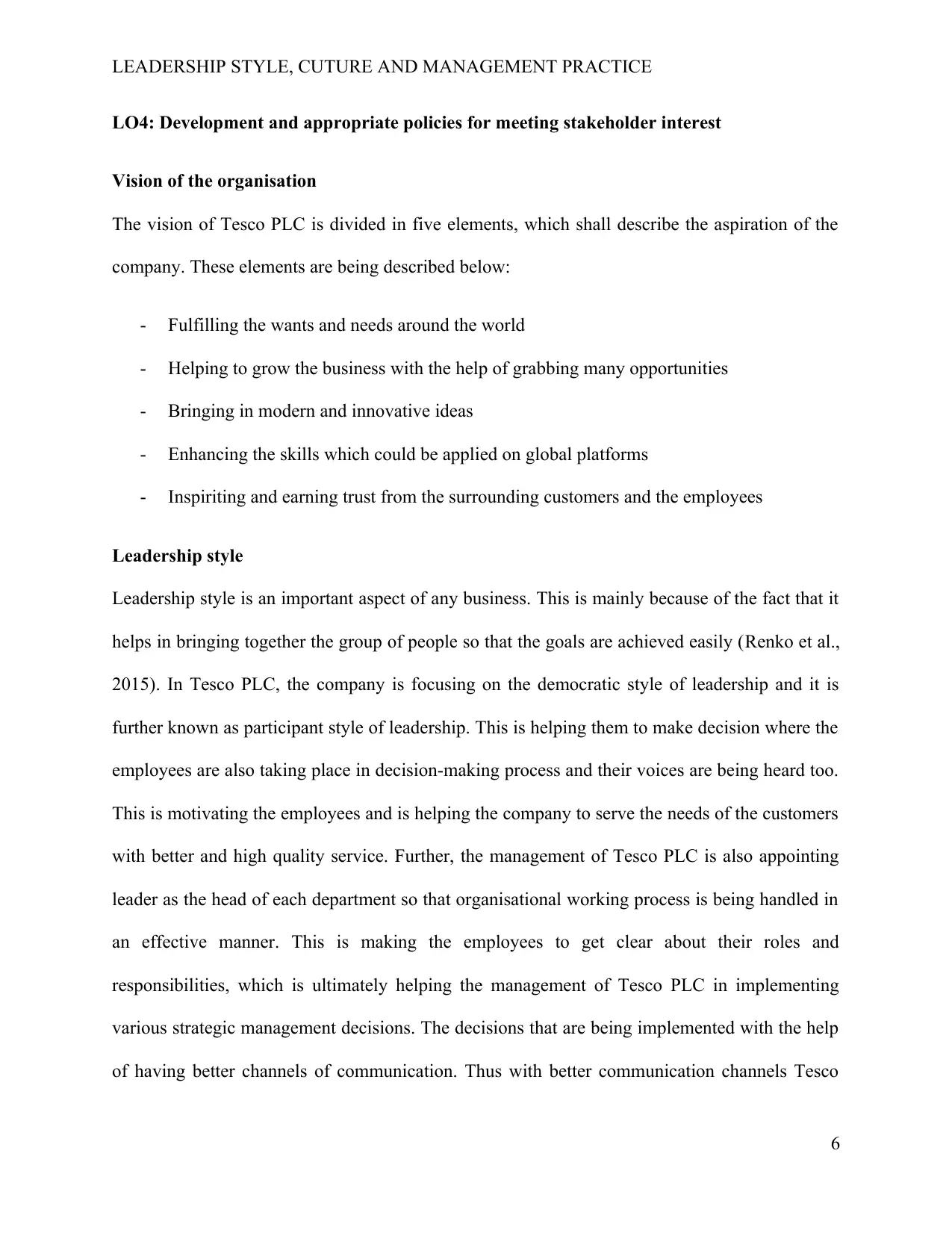
LEADERSHIP STYLE, CUTURE AND MANAGEMENT PRACTICE
LO4: Development and appropriate policies for meeting stakeholder interest
Vision of the organisation
The vision of Tesco PLC is divided in five elements, which shall describe the aspiration of the
company. These elements are being described below:
- Fulfilling the wants and needs around the world
- Helping to grow the business with the help of grabbing many opportunities
- Bringing in modern and innovative ideas
- Enhancing the skills which could be applied on global platforms
- Inspiriting and earning trust from the surrounding customers and the employees
Leadership style
Leadership style is an important aspect of any business. This is mainly because of the fact that it
helps in bringing together the group of people so that the goals are achieved easily (Renko et al.,
2015). In Tesco PLC, the company is focusing on the democratic style of leadership and it is
further known as participant style of leadership. This is helping them to make decision where the
employees are also taking place in decision-making process and their voices are being heard too.
This is motivating the employees and is helping the company to serve the needs of the customers
with better and high quality service. Further, the management of Tesco PLC is also appointing
leader as the head of each department so that organisational working process is being handled in
an effective manner. This is making the employees to get clear about their roles and
responsibilities, which is ultimately helping the management of Tesco PLC in implementing
various strategic management decisions. The decisions that are being implemented with the help
of having better channels of communication. Thus with better communication channels Tesco
6
LO4: Development and appropriate policies for meeting stakeholder interest
Vision of the organisation
The vision of Tesco PLC is divided in five elements, which shall describe the aspiration of the
company. These elements are being described below:
- Fulfilling the wants and needs around the world
- Helping to grow the business with the help of grabbing many opportunities
- Bringing in modern and innovative ideas
- Enhancing the skills which could be applied on global platforms
- Inspiriting and earning trust from the surrounding customers and the employees
Leadership style
Leadership style is an important aspect of any business. This is mainly because of the fact that it
helps in bringing together the group of people so that the goals are achieved easily (Renko et al.,
2015). In Tesco PLC, the company is focusing on the democratic style of leadership and it is
further known as participant style of leadership. This is helping them to make decision where the
employees are also taking place in decision-making process and their voices are being heard too.
This is motivating the employees and is helping the company to serve the needs of the customers
with better and high quality service. Further, the management of Tesco PLC is also appointing
leader as the head of each department so that organisational working process is being handled in
an effective manner. This is making the employees to get clear about their roles and
responsibilities, which is ultimately helping the management of Tesco PLC in implementing
various strategic management decisions. The decisions that are being implemented with the help
of having better channels of communication. Thus with better communication channels Tesco
6
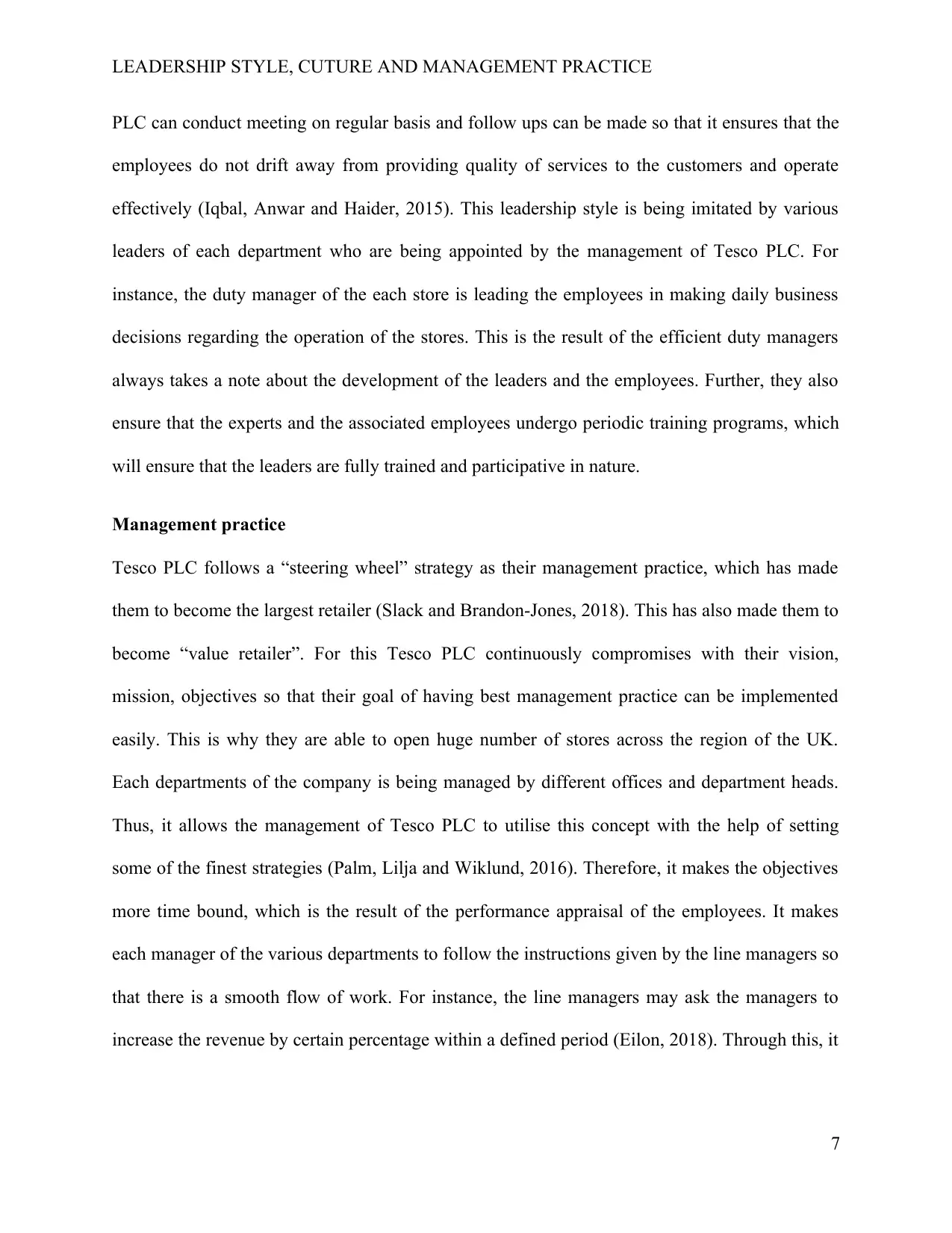
LEADERSHIP STYLE, CUTURE AND MANAGEMENT PRACTICE
PLC can conduct meeting on regular basis and follow ups can be made so that it ensures that the
employees do not drift away from providing quality of services to the customers and operate
effectively (Iqbal, Anwar and Haider, 2015). This leadership style is being imitated by various
leaders of each department who are being appointed by the management of Tesco PLC. For
instance, the duty manager of the each store is leading the employees in making daily business
decisions regarding the operation of the stores. This is the result of the efficient duty managers
always takes a note about the development of the leaders and the employees. Further, they also
ensure that the experts and the associated employees undergo periodic training programs, which
will ensure that the leaders are fully trained and participative in nature.
Management practice
Tesco PLC follows a “steering wheel” strategy as their management practice, which has made
them to become the largest retailer (Slack and Brandon-Jones, 2018). This has also made them to
become “value retailer”. For this Tesco PLC continuously compromises with their vision,
mission, objectives so that their goal of having best management practice can be implemented
easily. This is why they are able to open huge number of stores across the region of the UK.
Each departments of the company is being managed by different offices and department heads.
Thus, it allows the management of Tesco PLC to utilise this concept with the help of setting
some of the finest strategies (Palm, Lilja and Wiklund, 2016). Therefore, it makes the objectives
more time bound, which is the result of the performance appraisal of the employees. It makes
each manager of the various departments to follow the instructions given by the line managers so
that there is a smooth flow of work. For instance, the line managers may ask the managers to
increase the revenue by certain percentage within a defined period (Eilon, 2018). Through this, it
7
PLC can conduct meeting on regular basis and follow ups can be made so that it ensures that the
employees do not drift away from providing quality of services to the customers and operate
effectively (Iqbal, Anwar and Haider, 2015). This leadership style is being imitated by various
leaders of each department who are being appointed by the management of Tesco PLC. For
instance, the duty manager of the each store is leading the employees in making daily business
decisions regarding the operation of the stores. This is the result of the efficient duty managers
always takes a note about the development of the leaders and the employees. Further, they also
ensure that the experts and the associated employees undergo periodic training programs, which
will ensure that the leaders are fully trained and participative in nature.
Management practice
Tesco PLC follows a “steering wheel” strategy as their management practice, which has made
them to become the largest retailer (Slack and Brandon-Jones, 2018). This has also made them to
become “value retailer”. For this Tesco PLC continuously compromises with their vision,
mission, objectives so that their goal of having best management practice can be implemented
easily. This is why they are able to open huge number of stores across the region of the UK.
Each departments of the company is being managed by different offices and department heads.
Thus, it allows the management of Tesco PLC to utilise this concept with the help of setting
some of the finest strategies (Palm, Lilja and Wiklund, 2016). Therefore, it makes the objectives
more time bound, which is the result of the performance appraisal of the employees. It makes
each manager of the various departments to follow the instructions given by the line managers so
that there is a smooth flow of work. For instance, the line managers may ask the managers to
increase the revenue by certain percentage within a defined period (Eilon, 2018). Through this, it
7
Paraphrase This Document
Need a fresh take? Get an instant paraphrase of this document with our AI Paraphraser
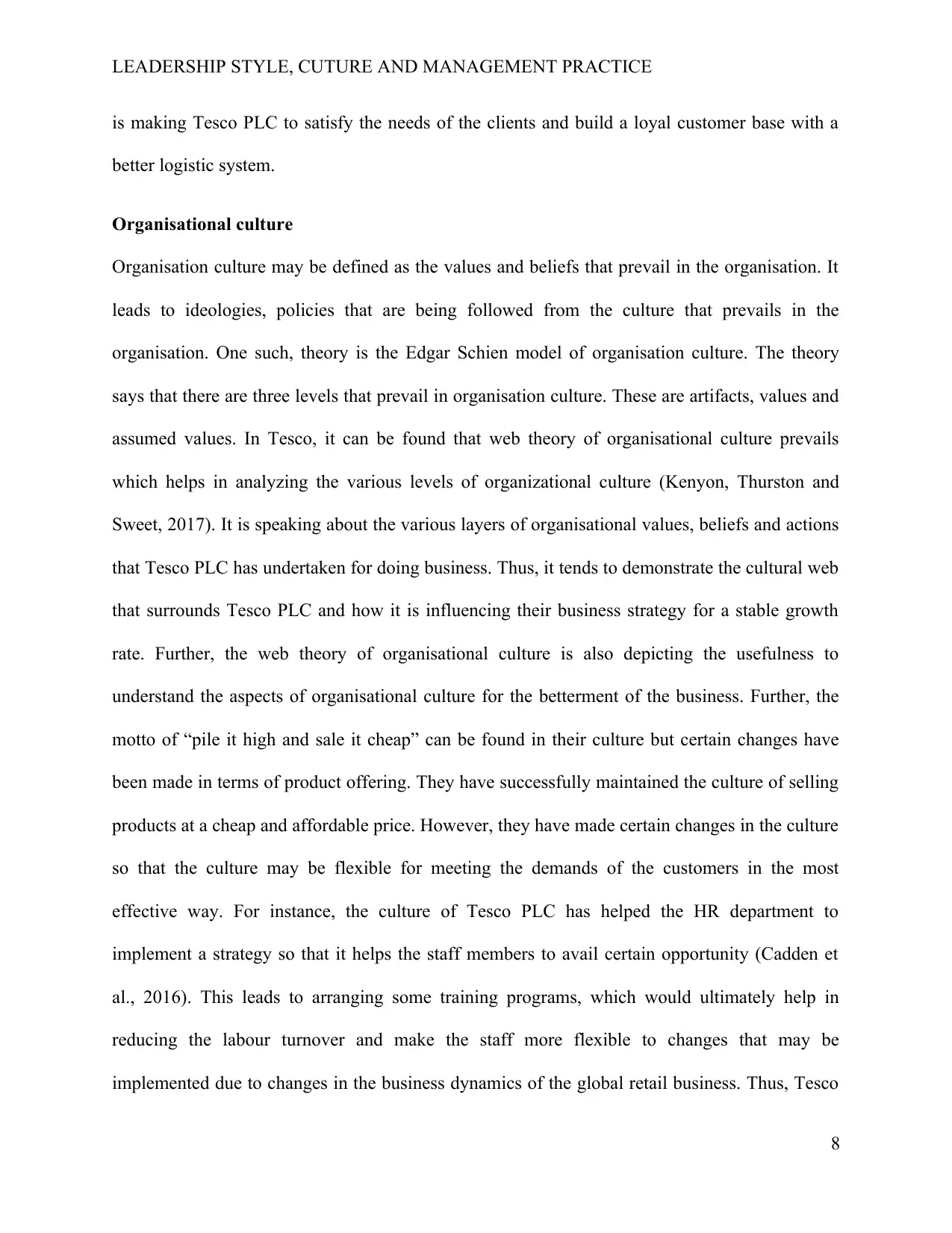
LEADERSHIP STYLE, CUTURE AND MANAGEMENT PRACTICE
is making Tesco PLC to satisfy the needs of the clients and build a loyal customer base with a
better logistic system.
Organisational culture
Organisation culture may be defined as the values and beliefs that prevail in the organisation. It
leads to ideologies, policies that are being followed from the culture that prevails in the
organisation. One such, theory is the Edgar Schien model of organisation culture. The theory
says that there are three levels that prevail in organisation culture. These are artifacts, values and
assumed values. In Tesco, it can be found that web theory of organisational culture prevails
which helps in analyzing the various levels of organizational culture (Kenyon, Thurston and
Sweet, 2017). It is speaking about the various layers of organisational values, beliefs and actions
that Tesco PLC has undertaken for doing business. Thus, it tends to demonstrate the cultural web
that surrounds Tesco PLC and how it is influencing their business strategy for a stable growth
rate. Further, the web theory of organisational culture is also depicting the usefulness to
understand the aspects of organisational culture for the betterment of the business. Further, the
motto of “pile it high and sale it cheap” can be found in their culture but certain changes have
been made in terms of product offering. They have successfully maintained the culture of selling
products at a cheap and affordable price. However, they have made certain changes in the culture
so that the culture may be flexible for meeting the demands of the customers in the most
effective way. For instance, the culture of Tesco PLC has helped the HR department to
implement a strategy so that it helps the staff members to avail certain opportunity (Cadden et
al., 2016). This leads to arranging some training programs, which would ultimately help in
reducing the labour turnover and make the staff more flexible to changes that may be
implemented due to changes in the business dynamics of the global retail business. Thus, Tesco
8
is making Tesco PLC to satisfy the needs of the clients and build a loyal customer base with a
better logistic system.
Organisational culture
Organisation culture may be defined as the values and beliefs that prevail in the organisation. It
leads to ideologies, policies that are being followed from the culture that prevails in the
organisation. One such, theory is the Edgar Schien model of organisation culture. The theory
says that there are three levels that prevail in organisation culture. These are artifacts, values and
assumed values. In Tesco, it can be found that web theory of organisational culture prevails
which helps in analyzing the various levels of organizational culture (Kenyon, Thurston and
Sweet, 2017). It is speaking about the various layers of organisational values, beliefs and actions
that Tesco PLC has undertaken for doing business. Thus, it tends to demonstrate the cultural web
that surrounds Tesco PLC and how it is influencing their business strategy for a stable growth
rate. Further, the web theory of organisational culture is also depicting the usefulness to
understand the aspects of organisational culture for the betterment of the business. Further, the
motto of “pile it high and sale it cheap” can be found in their culture but certain changes have
been made in terms of product offering. They have successfully maintained the culture of selling
products at a cheap and affordable price. However, they have made certain changes in the culture
so that the culture may be flexible for meeting the demands of the customers in the most
effective way. For instance, the culture of Tesco PLC has helped the HR department to
implement a strategy so that it helps the staff members to avail certain opportunity (Cadden et
al., 2016). This leads to arranging some training programs, which would ultimately help in
reducing the labour turnover and make the staff more flexible to changes that may be
implemented due to changes in the business dynamics of the global retail business. Thus, Tesco
8
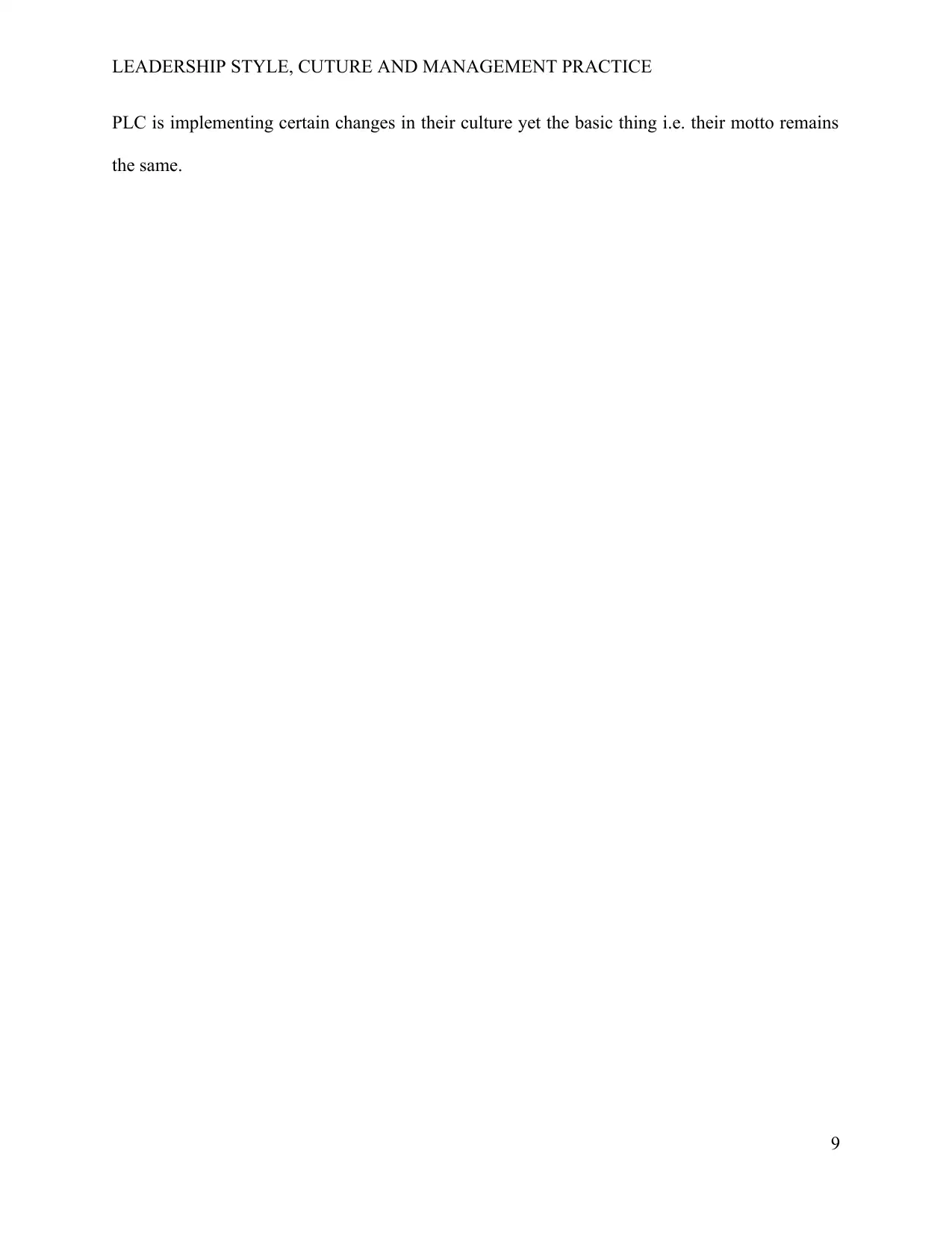
LEADERSHIP STYLE, CUTURE AND MANAGEMENT PRACTICE
PLC is implementing certain changes in their culture yet the basic thing i.e. their motto remains
the same.
9
PLC is implementing certain changes in their culture yet the basic thing i.e. their motto remains
the same.
9
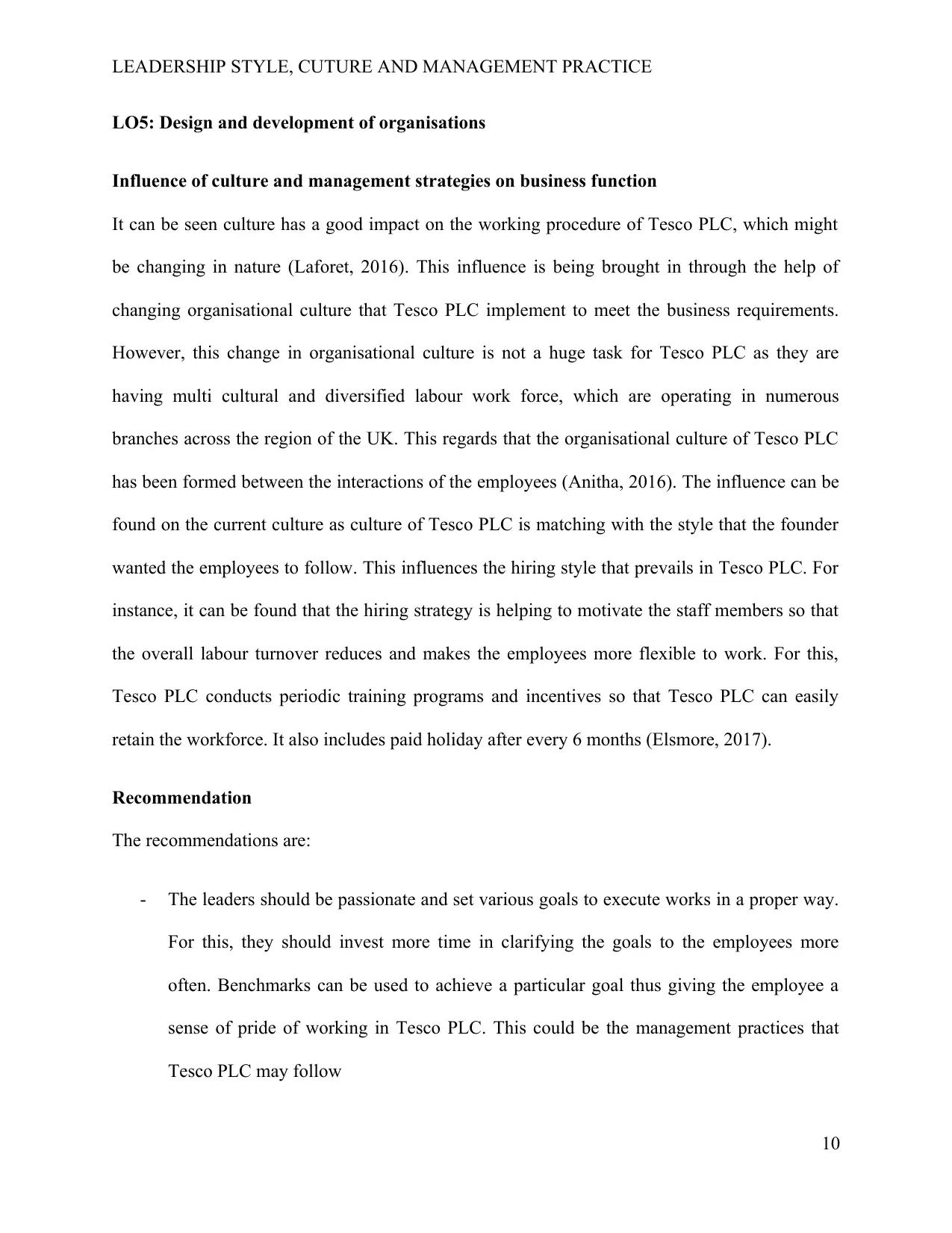
LEADERSHIP STYLE, CUTURE AND MANAGEMENT PRACTICE
LO5: Design and development of organisations
Influence of culture and management strategies on business function
It can be seen culture has a good impact on the working procedure of Tesco PLC, which might
be changing in nature (Laforet, 2016). This influence is being brought in through the help of
changing organisational culture that Tesco PLC implement to meet the business requirements.
However, this change in organisational culture is not a huge task for Tesco PLC as they are
having multi cultural and diversified labour work force, which are operating in numerous
branches across the region of the UK. This regards that the organisational culture of Tesco PLC
has been formed between the interactions of the employees (Anitha, 2016). The influence can be
found on the current culture as culture of Tesco PLC is matching with the style that the founder
wanted the employees to follow. This influences the hiring style that prevails in Tesco PLC. For
instance, it can be found that the hiring strategy is helping to motivate the staff members so that
the overall labour turnover reduces and makes the employees more flexible to work. For this,
Tesco PLC conducts periodic training programs and incentives so that Tesco PLC can easily
retain the workforce. It also includes paid holiday after every 6 months (Elsmore, 2017).
Recommendation
The recommendations are:
- The leaders should be passionate and set various goals to execute works in a proper way.
For this, they should invest more time in clarifying the goals to the employees more
often. Benchmarks can be used to achieve a particular goal thus giving the employee a
sense of pride of working in Tesco PLC. This could be the management practices that
Tesco PLC may follow
10
LO5: Design and development of organisations
Influence of culture and management strategies on business function
It can be seen culture has a good impact on the working procedure of Tesco PLC, which might
be changing in nature (Laforet, 2016). This influence is being brought in through the help of
changing organisational culture that Tesco PLC implement to meet the business requirements.
However, this change in organisational culture is not a huge task for Tesco PLC as they are
having multi cultural and diversified labour work force, which are operating in numerous
branches across the region of the UK. This regards that the organisational culture of Tesco PLC
has been formed between the interactions of the employees (Anitha, 2016). The influence can be
found on the current culture as culture of Tesco PLC is matching with the style that the founder
wanted the employees to follow. This influences the hiring style that prevails in Tesco PLC. For
instance, it can be found that the hiring strategy is helping to motivate the staff members so that
the overall labour turnover reduces and makes the employees more flexible to work. For this,
Tesco PLC conducts periodic training programs and incentives so that Tesco PLC can easily
retain the workforce. It also includes paid holiday after every 6 months (Elsmore, 2017).
Recommendation
The recommendations are:
- The leaders should be passionate and set various goals to execute works in a proper way.
For this, they should invest more time in clarifying the goals to the employees more
often. Benchmarks can be used to achieve a particular goal thus giving the employee a
sense of pride of working in Tesco PLC. This could be the management practices that
Tesco PLC may follow
10
Secure Best Marks with AI Grader
Need help grading? Try our AI Grader for instant feedback on your assignments.
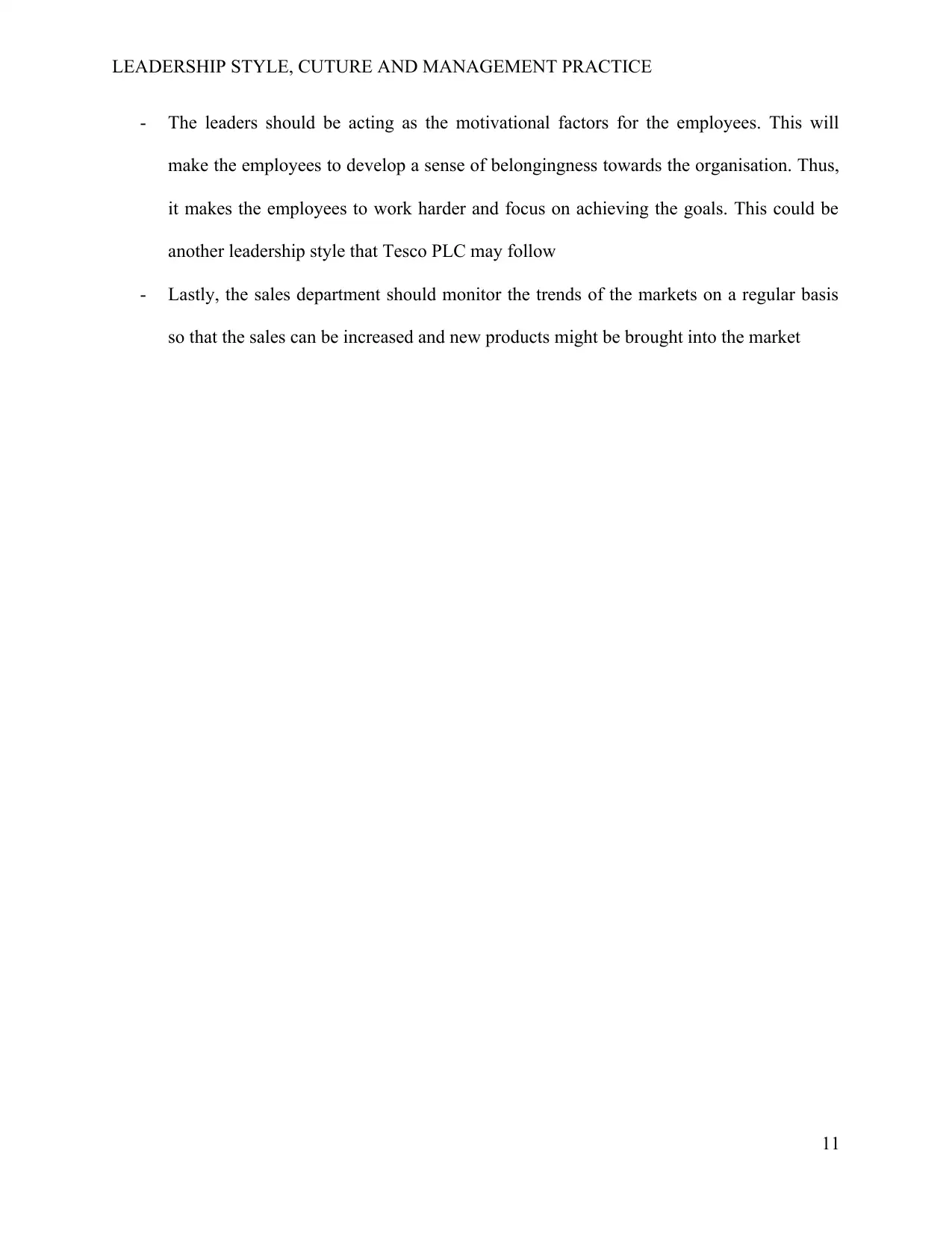
LEADERSHIP STYLE, CUTURE AND MANAGEMENT PRACTICE
- The leaders should be acting as the motivational factors for the employees. This will
make the employees to develop a sense of belongingness towards the organisation. Thus,
it makes the employees to work harder and focus on achieving the goals. This could be
another leadership style that Tesco PLC may follow
- Lastly, the sales department should monitor the trends of the markets on a regular basis
so that the sales can be increased and new products might be brought into the market
11
- The leaders should be acting as the motivational factors for the employees. This will
make the employees to develop a sense of belongingness towards the organisation. Thus,
it makes the employees to work harder and focus on achieving the goals. This could be
another leadership style that Tesco PLC may follow
- Lastly, the sales department should monitor the trends of the markets on a regular basis
so that the sales can be increased and new products might be brought into the market
11
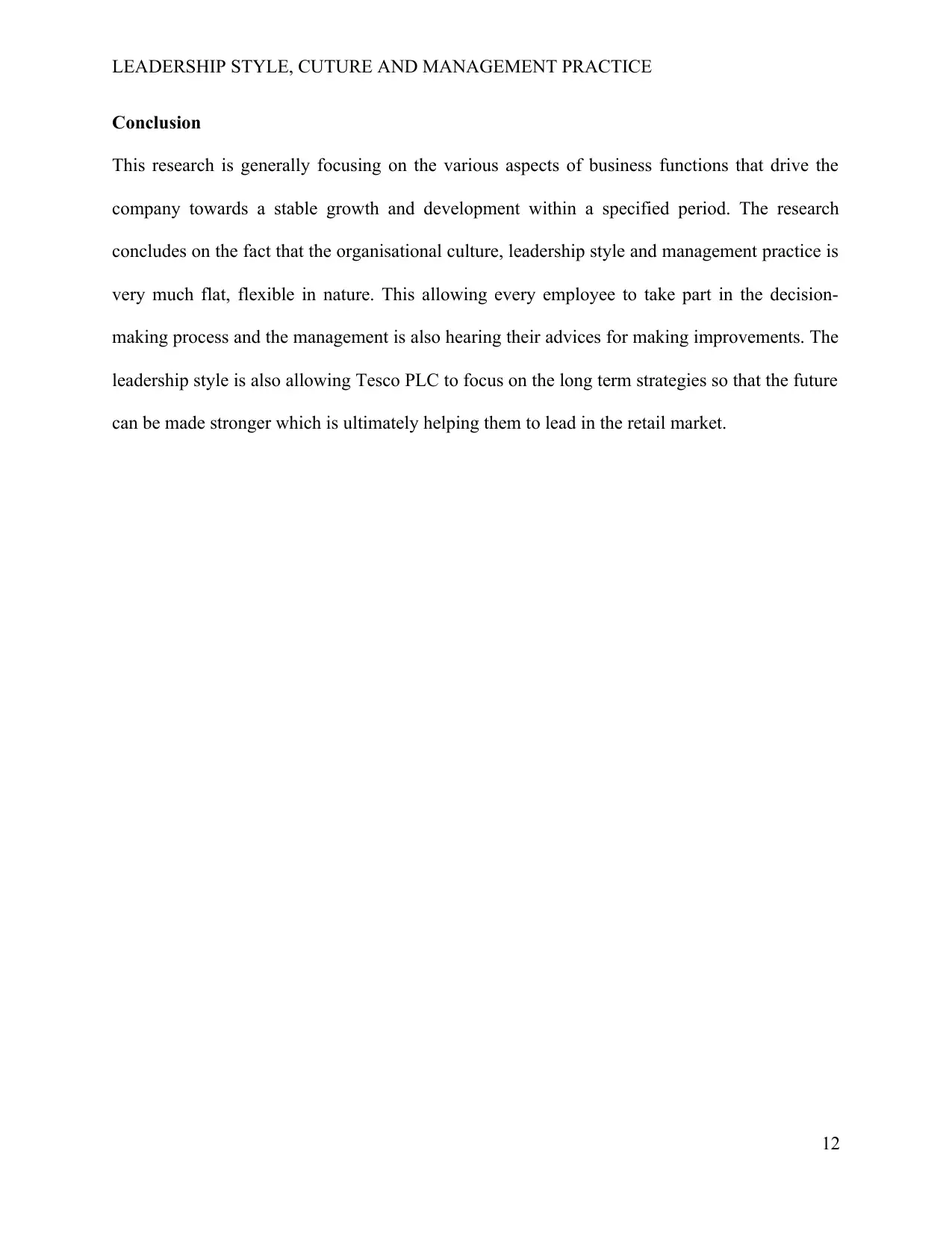
LEADERSHIP STYLE, CUTURE AND MANAGEMENT PRACTICE
Conclusion
This research is generally focusing on the various aspects of business functions that drive the
company towards a stable growth and development within a specified period. The research
concludes on the fact that the organisational culture, leadership style and management practice is
very much flat, flexible in nature. This allowing every employee to take part in the decision-
making process and the management is also hearing their advices for making improvements. The
leadership style is also allowing Tesco PLC to focus on the long term strategies so that the future
can be made stronger which is ultimately helping them to lead in the retail market.
12
Conclusion
This research is generally focusing on the various aspects of business functions that drive the
company towards a stable growth and development within a specified period. The research
concludes on the fact that the organisational culture, leadership style and management practice is
very much flat, flexible in nature. This allowing every employee to take part in the decision-
making process and the management is also hearing their advices for making improvements. The
leadership style is also allowing Tesco PLC to focus on the long term strategies so that the future
can be made stronger which is ultimately helping them to lead in the retail market.
12
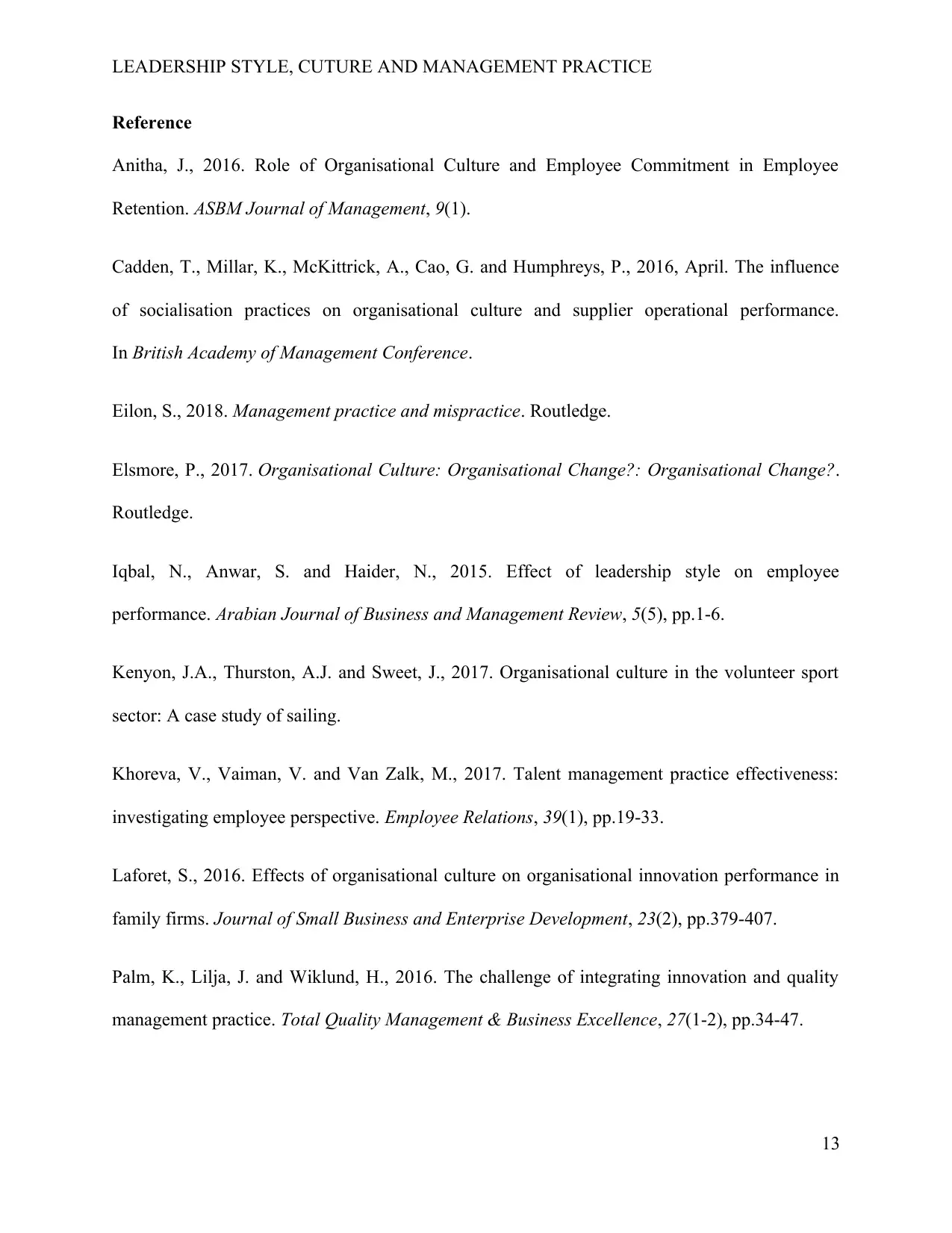
LEADERSHIP STYLE, CUTURE AND MANAGEMENT PRACTICE
Reference
Anitha, J., 2016. Role of Organisational Culture and Employee Commitment in Employee
Retention. ASBM Journal of Management, 9(1).
Cadden, T., Millar, K., McKittrick, A., Cao, G. and Humphreys, P., 2016, April. The influence
of socialisation practices on organisational culture and supplier operational performance.
In British Academy of Management Conference.
Eilon, S., 2018. Management practice and mispractice. Routledge.
Elsmore, P., 2017. Organisational Culture: Organisational Change?: Organisational Change?.
Routledge.
Iqbal, N., Anwar, S. and Haider, N., 2015. Effect of leadership style on employee
performance. Arabian Journal of Business and Management Review, 5(5), pp.1-6.
Kenyon, J.A., Thurston, A.J. and Sweet, J., 2017. Organisational culture in the volunteer sport
sector: A case study of sailing.
Khoreva, V., Vaiman, V. and Van Zalk, M., 2017. Talent management practice effectiveness:
investigating employee perspective. Employee Relations, 39(1), pp.19-33.
Laforet, S., 2016. Effects of organisational culture on organisational innovation performance in
family firms. Journal of Small Business and Enterprise Development, 23(2), pp.379-407.
Palm, K., Lilja, J. and Wiklund, H., 2016. The challenge of integrating innovation and quality
management practice. Total Quality Management & Business Excellence, 27(1-2), pp.34-47.
13
Reference
Anitha, J., 2016. Role of Organisational Culture and Employee Commitment in Employee
Retention. ASBM Journal of Management, 9(1).
Cadden, T., Millar, K., McKittrick, A., Cao, G. and Humphreys, P., 2016, April. The influence
of socialisation practices on organisational culture and supplier operational performance.
In British Academy of Management Conference.
Eilon, S., 2018. Management practice and mispractice. Routledge.
Elsmore, P., 2017. Organisational Culture: Organisational Change?: Organisational Change?.
Routledge.
Iqbal, N., Anwar, S. and Haider, N., 2015. Effect of leadership style on employee
performance. Arabian Journal of Business and Management Review, 5(5), pp.1-6.
Kenyon, J.A., Thurston, A.J. and Sweet, J., 2017. Organisational culture in the volunteer sport
sector: A case study of sailing.
Khoreva, V., Vaiman, V. and Van Zalk, M., 2017. Talent management practice effectiveness:
investigating employee perspective. Employee Relations, 39(1), pp.19-33.
Laforet, S., 2016. Effects of organisational culture on organisational innovation performance in
family firms. Journal of Small Business and Enterprise Development, 23(2), pp.379-407.
Palm, K., Lilja, J. and Wiklund, H., 2016. The challenge of integrating innovation and quality
management practice. Total Quality Management & Business Excellence, 27(1-2), pp.34-47.
13
Paraphrase This Document
Need a fresh take? Get an instant paraphrase of this document with our AI Paraphraser
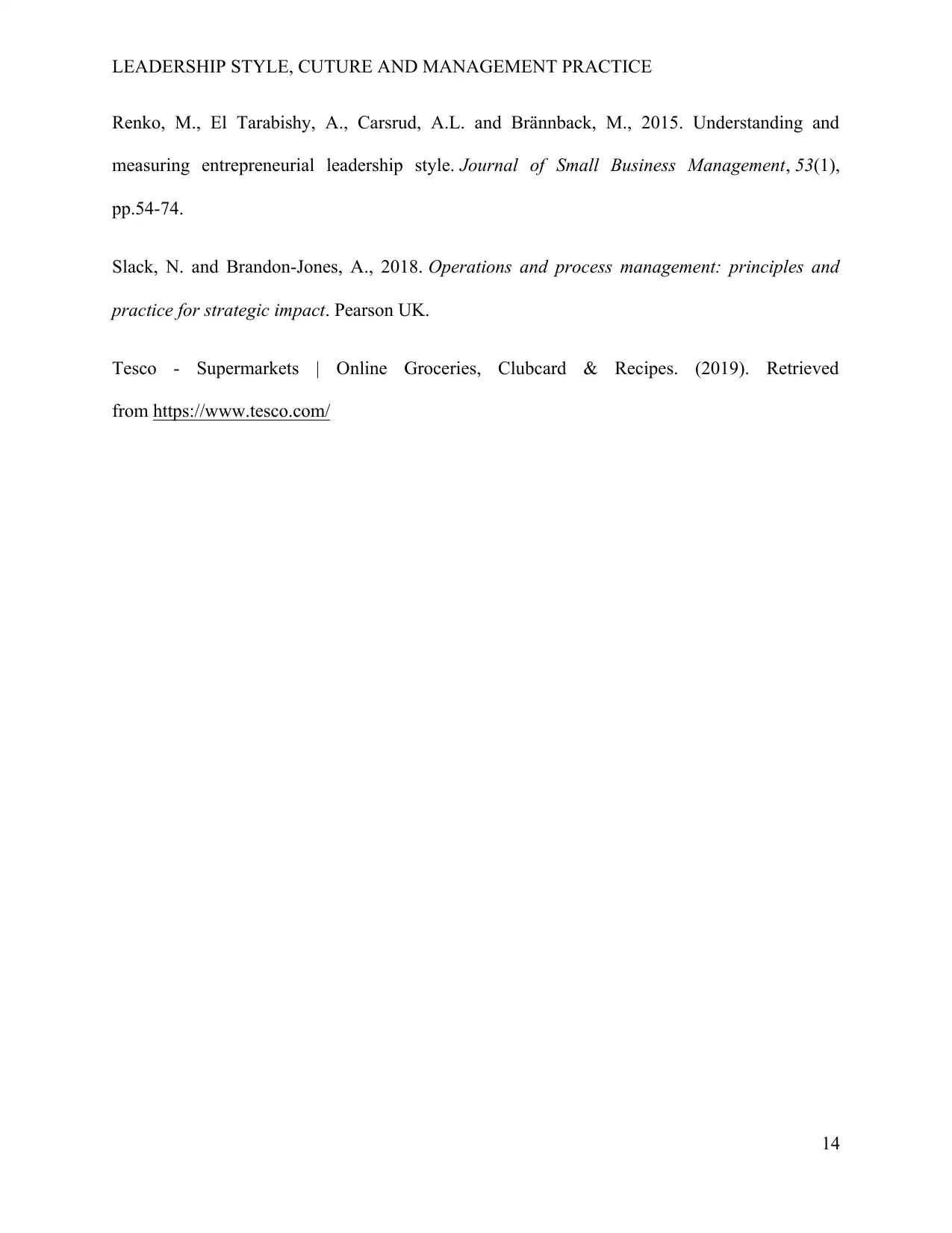
LEADERSHIP STYLE, CUTURE AND MANAGEMENT PRACTICE
Renko, M., El Tarabishy, A., Carsrud, A.L. and Brännback, M., 2015. Understanding and
measuring entrepreneurial leadership style. Journal of Small Business Management, 53(1),
pp.54-74.
Slack, N. and Brandon-Jones, A., 2018. Operations and process management: principles and
practice for strategic impact. Pearson UK.
Tesco - Supermarkets | Online Groceries, Clubcard & Recipes. (2019). Retrieved
from https://www.tesco.com/
14
Renko, M., El Tarabishy, A., Carsrud, A.L. and Brännback, M., 2015. Understanding and
measuring entrepreneurial leadership style. Journal of Small Business Management, 53(1),
pp.54-74.
Slack, N. and Brandon-Jones, A., 2018. Operations and process management: principles and
practice for strategic impact. Pearson UK.
Tesco - Supermarkets | Online Groceries, Clubcard & Recipes. (2019). Retrieved
from https://www.tesco.com/
14
1 out of 14
Related Documents
Your All-in-One AI-Powered Toolkit for Academic Success.
+13062052269
info@desklib.com
Available 24*7 on WhatsApp / Email
![[object Object]](/_next/static/media/star-bottom.7253800d.svg)
Unlock your academic potential
© 2024 | Zucol Services PVT LTD | All rights reserved.





